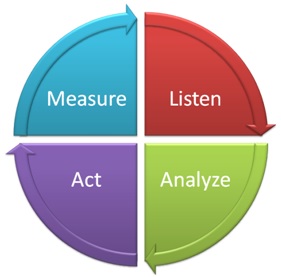Similar to the Chief Executive (CEO) of a company, a Product Manager should also question the process that goes into the creation of a product / service. Treating the organization like a living and breathing creature, a Product Manager should have in-depth understanding of the workings of its vital organs that are responsible for the following:
- Listening to external and internal business related signals
- Analyzing the impact of the data signals collected from external and internal sources
- Taking appropriate actions based on impact analysis
- Measuring the effectiveness of the actions
If one or more of these vital functions are broken, then the organization cannot function at its peak capacity and may succumb to the dynamic business environment. One of the most critical questions to ask in any situation is…’What does it mean?’ ‘it’ could be an data point or an event or any other external / internal stimulus. Then look at ‘it’ from different perspectives such as:
- What does it mean from business perspective?
- What does it mean from revenue perspective?
- What does it mean from process perspective?
- What does it mean from marketing perspective? Etc…
Listening
A Product Manager should tap into and harvest as many sources of information as possible. Getting external business signals is not only a function of number of sources but also the frequencies with these sources are tapped into. It’s the continuous ‘chatter’ that really matters. Collecting information once in a while is not sufficient and may lead to incomplete information. Here are some of the questions that must be asked when validating the data collected from sources of listening
- What sources of data collection were used?
a. Internal
- i. Customer service
- ii. Marketing
- iii. Sales, etc
b. External
- i. Customers
- ii. Competition
- iii. Industry experts
- iv. Company executives
- v. Partners, etc
- How recent is the data?
- How frequently was this data collected?
- Which systems were leveraged to pull the data from? (e.g CRM)
- How many direct customer inputs does this data include?
- How valuable are these customers to the business?
- Which revenue and vertical segments do they belong to?
- How frequently was the data processed and conclusions from that data refreshed?
- Who has reviewed this data prior to being getting used in the road mapping process?
Inside Out Data Collection
 Product Manager doesn’t necessarily have to wait for signals to come from outside. In order to be on the top of the game the Product Manager can also initiate ‘Inside Out’ process for getting the pulse of the market and business environment. For example during the process of building business case for new feature / product or when conceptualizing solution at the time of writing PRD, the Product Manager can reach out to Customers, partners and internal entities.
Product Manager doesn’t necessarily have to wait for signals to come from outside. In order to be on the top of the game the Product Manager can also initiate ‘Inside Out’ process for getting the pulse of the market and business environment. For example during the process of building business case for new feature / product or when conceptualizing solution at the time of writing PRD, the Product Manager can reach out to Customers, partners and internal entities.
These are some of the questions that a Product Manager must ask of him / team in order to ensure inside out approach of data collection:
- How many customers were involved in PRD process?
- How frequently were the customers contacted?
- How many of those customers are expected to use the feature / product after it’s rolled out?
- How many customers are holding their breath for the feature to be rolled out?
- How many prospects are cancelling deals for the feature?
- In which revenue and value bands do these Customers fall under?
- How the does the actual customer interactions compare with planned customer interactions?
Other entities within the organization that can use the Inside out approach are Marketing and Sales teams. For example Marketing team can involve Customers in the process of creating case studies and white papers.
Analyze Impact (immediate, medium and long term)
Once the data is collected and processed the next critical activity is to analyze the impact of that on the various aspects of the organization. Understanding only the Product impact is not sufficient. A holistic organization impact assessment should be done. The impact assessment questions that follow can be asked to:
- Assess the impact of external events such as a competitor make announcements or change in industry regulations, etc.
- Assess the impact of features on roadmap, etc.
The goal is to really get a thorough understanding of the impact of external and internal events on the business.
- What is the revenue impact?
- What is the customer acquisition impact?
- What is the customer relationship impact?
- What is the new vertical (market) impact?
- What is the impact on strengthening position in the existing verticals?
- Impact on brand value of the company?
- What is the impact on employee skills acquisition?
- What is the marketing impact?
- Case study
- White paper
- References, etc
- How does the roadmap help plug competitive gaps?
- Fill gap
- Create gap
- How does the roadmap help displace competition?
- How does the roadmap help create though leadership?
- How does the roadmap differentiation from the competition?
- What Sales and Support changes need to be made?
- What Marketing changes need to be made?
- What changes need to be made to the Product development plan?
I’m sure most readers can add to this list of questions and make it even richer and actionable for Product Managers. Remember the path to the right solutions begin by asking the right questions…


